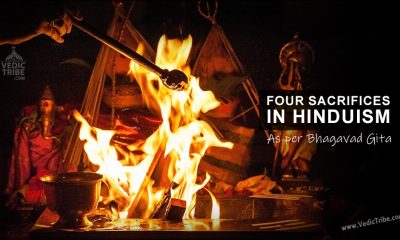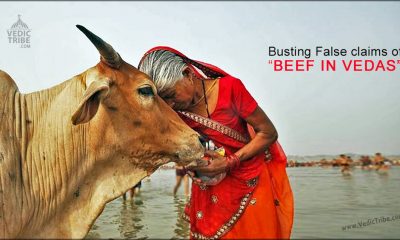Jainism
Transtheistic Jainism – Divinity without God
Published
5 years agoon
By
Vedic Tribe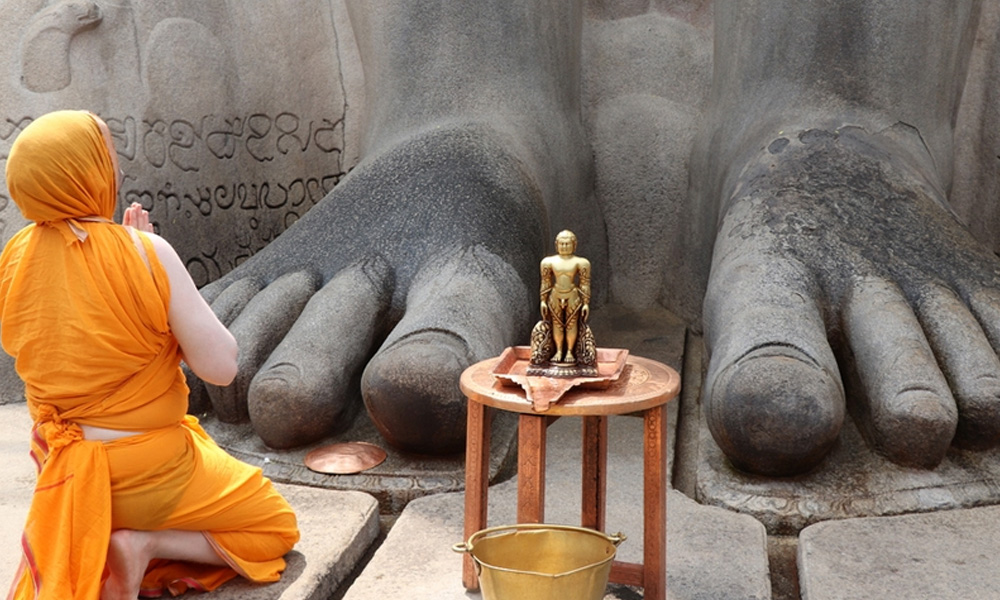
Jains do not believe in a God or gods in the way that many other religions do, but they do believe in divine (or at least perfect) beings who are worthy of devotion.
This makes it difficult to give a straight answer to the question “is Jainism atheistic?” The scholar Heinrich Zimmer suggested that a new word was needed: transtheistic, meaning “inaccessible by arguments as to whether or not a God exists”.
God and the problem of evil
The Jain view of God enables Jainism to explain the evil and suffering that exists in the world without the intellectual difficulties faced by religions that have an omnipotent, wholly good, creator God at their heart.
Where religions such as Christianity find the problem of evil one of their toughest tests, Jains use the existence of evil as a reason for denying the existence of an omnipotent, wholly good, Creator.
Jainism and God – the theistic side
Some writers regard the jinas as ‘gods’ because the jinas are venerated by Jains in the way that other faiths worship gods or God.
Jains venerate them because they have achieved perfection, and have become liberated from the cycle of birth and death.
The jinas are the ideal state of an individual soul’s existence, and are worshipped as a perfect example for Jains to aspire to. So the only ‘gods’ that exist for Jains are pure souls that are omniscient, perfectly happy and eternal.
All of us could become such a ‘god’ because every being has the potential to become such a perfect soul.
In many ways the Jain attitude to perfect beings is both intelligible and satisfying, and sufficient to demolish the claim that Jainism is an atheistic religion. If one wants to argue that Jainism is atheistic then one must do so from a specific, limited, idea of what it means to be divine.
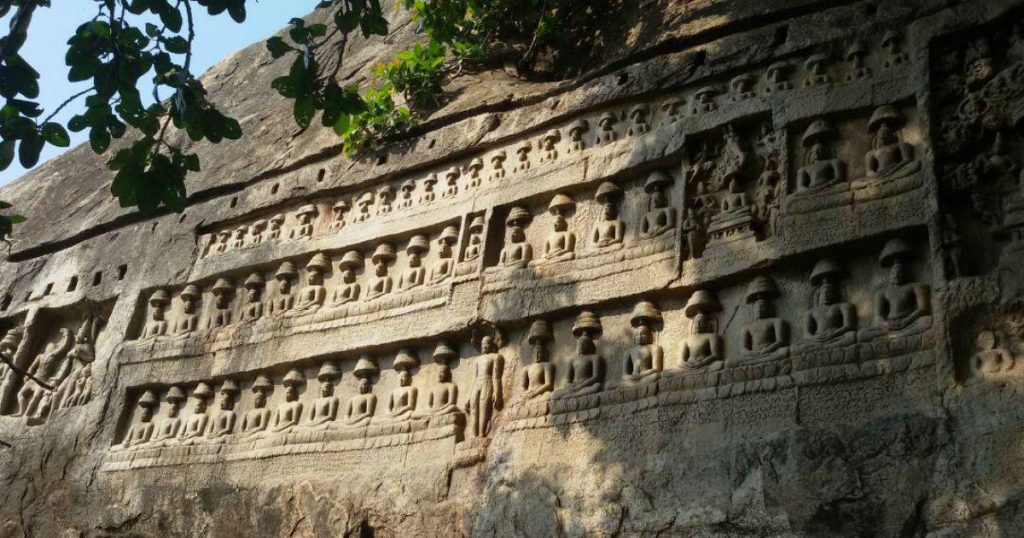
Prayers
Jain prayers aren’t like the God-focussed prayers found in Christianity. Instead Jain prayers tend to recall the great qualities of the tirthankaras and remind the individual of various teachings.
Jainism and God – the atheistic side
Jains do not believe that the universe was created by God or by any other creative spirit. Jain writings are scornful of the very idea:
– If God created the world, where was he before creation? If you say he was transcendent then, and needed no support, where is he now?
– No single being had the skill to make this world — For how can an immaterial god create that which is material?
– If God is ever perfect and complete, how could the will to create have arisen in him? If, on the other hand, he is not perfect, he could no more create the universe than a potter could.
There is no God to maintain the universe
Jains do not believe that any form of god is necessary to keep the universe in existence, or that any form of god has any power over the universe.
There is no God of judgement
Jains do not believe in that sort of judgement. Jains believe that the goodness or quality of a being’s life are determined by karma.
Jains believe that karma is a physical process, and nothing to do with spiritual beings.
There is no God the ruler
Jains do not believe that there is a god who must be obeyed.
There is no God who helps people
Jains do not believe in any god who will respond to prayer or intervene in the world. The beings that Jains worship have no interest in human beings.
The beings that Jains worship are beyond human contact and they cannot intervene in the world.
There is no God who demands worship
The perfect beings that Jains worship have no interest in human beings.
Any being that desired anything would not be perfect and thus not a god.
There is no God compared to whom each of us will always be inferior
Every soul has the potential to become perfect. All perfect souls are equal.
The heavenly beings are not gods
The beings that live in the heavenly kingdoms are not gods since they are still subject to karma and reincarnation. These beings are called devas.
~ Source: BBC
You may like
History
Fatehpur Sikri was built on ruins of Hindu and Jain City Saikrikya
Published
5 years agoon
November 5, 2020By
Vedic Tribe
Fatehpur Sikri, that Mughal emperor Akbar established as his capital and is now a World Heritage site, was once a “flourishing trade and Jain pilgrimage centre”.
Basing his arguments on the excavations by the Archaeological Survey of India (ASI) in 1999-2000 at the Chabeli Tila, senior Agra journalist Bhanu Pratap Singh said the antique pieces, statues, and structures all point to a lost “culture and religious site,” more than 1,000 years ago.
“The excavations yielded a rich crop of Jain statues, hundreds of them, including the foundation stone of a temple with the date. The statues were a thousand years old of Bhagwan Adi Nath, Bhagwan Rishabh Nath, Bhagwan Mahavir and Jain Yakshinis,” said Swarup Chandra Jain, senior leader of the Jain community. The Jains comprise about 0.4 percent of India’s population of 1.2 billion and are a generally religious, prosperous and literate community.
Fatehpur Sikri is popularly known as the Capital city of Mughal established by Akbar but it has thousands of years of cultural history prior to it as Saikrikya.
Archaeological explorations in this region have revealed prehistoric stone tools, rock shelters with paintings on the periphery of the lake.
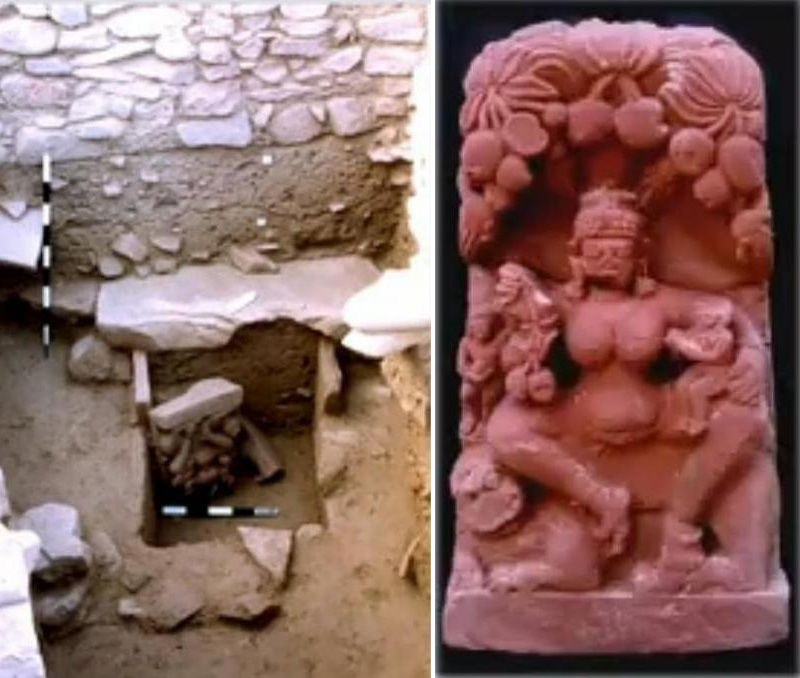
Broken heads of various Jaina sculpture and chisel marks is evident of iconoclasm by Muslim invaders after 10th century CE. Very important archaeological evidence of religious disposal of mutilated sculptures was traced in the form of a man-made pit built of stone-slabs dug by the people during that era. It was prepared for religious disposal of Jain idols to prevent Iconoclasm by Muslims invaders.
Excavations were done at Birchhabili-Tila (Mound), which is 2 Km away from the Fatehpur Sikri fort.
There are multiple idols of Jain and Hindu gods found in this area along with inscriptions using both Brahmi and Nagari scripts in Sanskrit and local dialets.
One such 3 lined inscription on the pedestal of the image of Strutidevi Jaina Saraswati refers to the kingdom or king as ‘Vajramrajye‘ and locality as ‘Santi Vimal Acharya Vastu‘ and ‘Saikrikya‘.
The word ‘Saikrikya‘ is same as Sikri and ‘Vajram‘ as Kachhchhapaghata ruler.
Fatehpur Sikri was Vijayapur Sikri (original hindu name) before Akbar built a fort on ruins. Fateh and Vijay means same (victory).
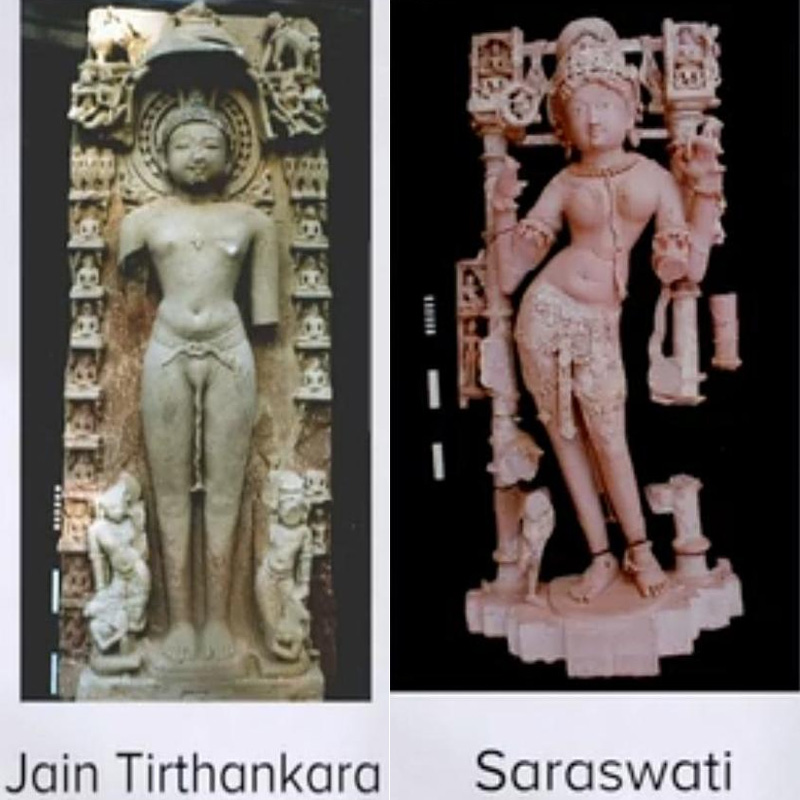
Discovery of Jaina Srutidevi Saraswati in Tribhanga posture, four-armed with varada, kamala, pustaka and mala in her hands, with a halo, rich ornaments and the vehicle hamsa is unique. It bears inscription dated in Vikram Samvat 1069 (1010 CE).
Saikrikya was inhabited almost since 10000 BCE as Neolithic celts were found here.
Historian Sugam Anand said: “The findings should have led to serious research, but that was not done. You need time and resources. Definitely before Akbar built his capital in Fatehpur Sikri, there is proof of habitation, of temples and commercial centres. The open space on the ridge was used by Akbar to build his capital. But we still need a lot of research.”
The statues and artifacts discovered buried in a pond have been kept in a guest house in Fatehpur Sikri by the ASI.

Bhanu Pratap Singh, the author of “Jain Dharm Ka Pramukh Kendra Tha Fatehpur Sikri,” said: “Sikri existed much before Akbar. The excavations have clearly established this fact.”
D.V. Sharma, former superintending archaeologist of the ASI in Agra, who supervised the excavations, said: “We found scores of damaged statues piled up, and with dates, also a manuscript. These are now lying in the guest house at Fatehpur Sikri. They should have gone ahead with the excavations and engaged historians to research on the subject.”
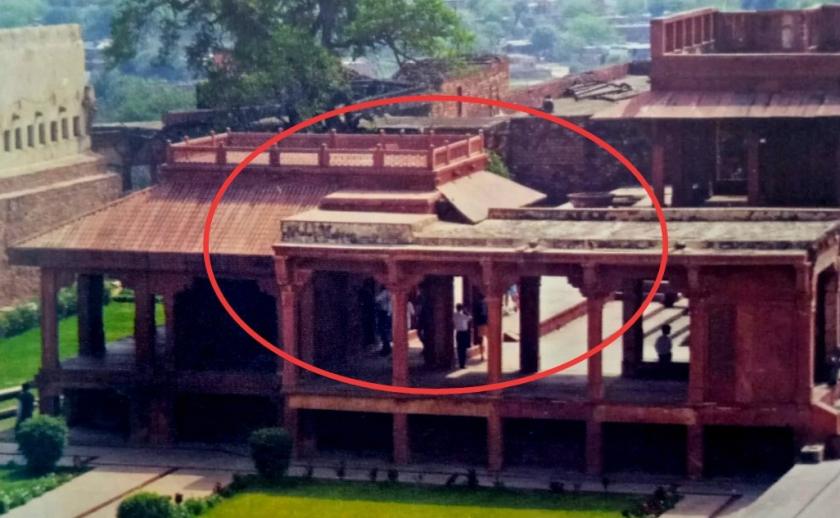
After invasion, destruction and loot, this area was deserted for some time and later Mughals came in.
“My book on Fatehpur Sikri excavations is there in the ASI library with complete details of the findings which unmistakably point to a flourishing trade and pilgrimage centre of both the Jains and the Sikarwars. Akbar built a few structures and modified others that were already there. Who demolished the temples and the statues is a subject which further research alone can establish,” Sharma added.
The ASI, for reasons known only to itself, abruptly stopped excavations at Fatehpur Sikri. “Had they pursued and dug up all the mounds, startling revelations would have been made that would have changed the course of our historical understanding,” Bhanu Pratap Singh claimed.

Clearly the mughal construction in Fatehpur Sikri complex were a mere additions to pre-existing Rajput Architecture.
Prior to the excavations in 1999, the ASI, in its various publications, had categorically stated: “Before Akbar’s time, the higher ridge was uninhabited, its former glory and present fame are the result of a sufi saint’s choice of it as a hermitage.”
But ASI’s documents do refer to Sikri village, “a site full of interest and promise for archaeological exploration”.
Bhanu Pratap Singh said the Fatehpur Sikri area was under the Sikarwar Rajputs, who had many structures and palaces, including a fort and temples, which were either demolished or suitably modified by the Mughals and before them by the Muslim rulers. Fatehpur Sikri was earlier Vijay Pur, according to the ASI’s D.V. Sharma.
The Jain community in Agra plans to develop a museum in Fatehpur Sikri to tell the world “the real history of the area”, according to philanthropist Ashok Jain, a chartered accountant.
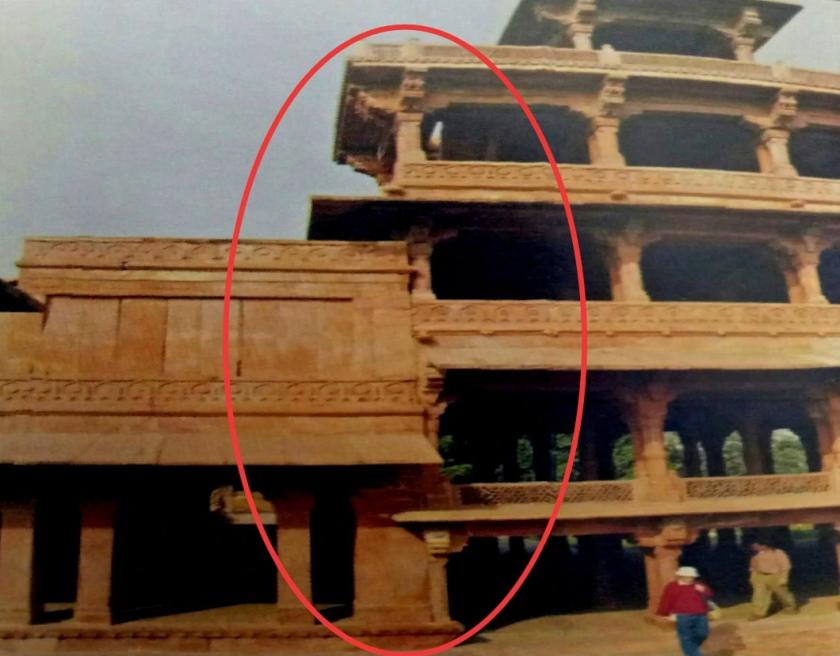
Imperfections in Pillars, doorways, jharokhas and ceiling of Mughal additions are apparent.
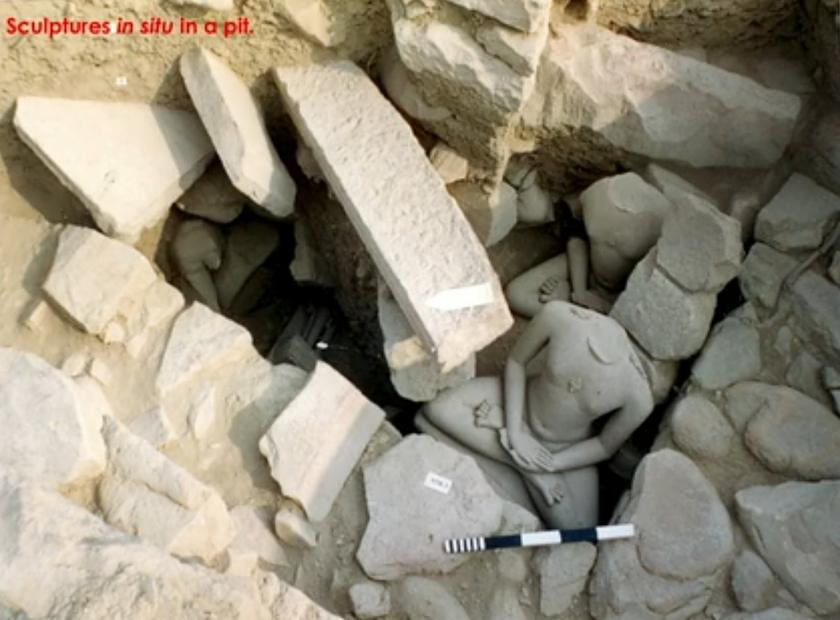
Jain Teerthankar Adinatha idol was found beheaded in a pit.

Pillars and walkways also depict Rajput style architecture.
Images Credit : Dr. D.V.Sharma (Archaeologist)
Jainism
Five Fundamental Beliefs of Jainism
Published
5 years agoon
October 22, 2020By
Vedic Tribe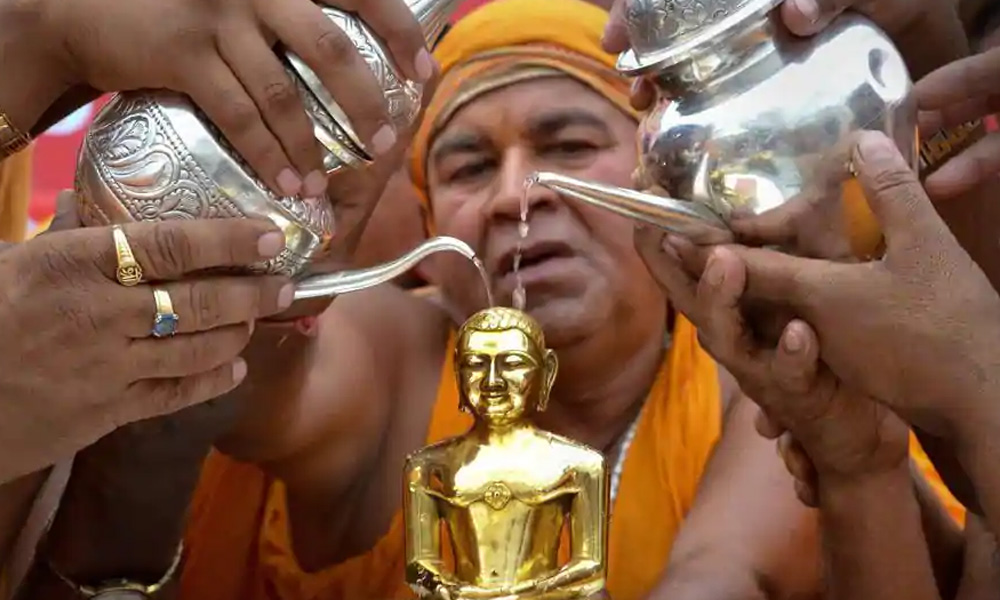
-By SRI BEN PRABHU
The term Religion is combination of two words, ‘Re’ and ‘ligare’, where ‘Re’ means again and ‘ligare’ means to connect, tie, bind. So, the term Religion means to connect again. Every living form on this earth is disconnected from its true source i.e. Eternal Pure Consciousness. Only human beings have the privilege to return to that state of pure consciousness. Thus, Religion, essentially means the art connecting again to the lost world and religious sects means the organised institutions that teach the art, ways, methods of disconnecting from temporary world and connecting to Eternal world.
The Role of Religious Sects
There are several religious sects prevailing in todays world like Hinduism, Jainism, Sikhism, Buddhism etc. These ‘-isms’ actually means ‘the way of life’ and living. So, when we say about the religion Jainism — we actually mean jain way of life and living to connect to eternal pure consciousness. When we talk about Hindu Religion — we mean hindu ways of life and living to connect to Infinite pure consciousness. Since the experience of this Pure Consciousness is blissfulness (i.e. eternal and infinite happiness) every human being is naturally inclined towards the path of religion.
Five Fundamentals of Jainism
From the perspective of Jainism, we hereby lay down the five fundamental principles of jainism that actually means the five step-by-step to live this human life in such a way that we experience the state of peace and bliss within.
1. Non-violence (Ahimsa)
The first fundamental way of living is non-violence as Lord Mahavira said, “Ahimsa Paramo Dharma”. The all-inclusive aspect of non-violence depicts three essential ethics in day to day living, namely
- Non-hurting — This is the grossest form of non-violence explaining no physical hurt towards any form of life, knowingly or unknowingly. Being a human is the most valuable life as it has the power to save others from hurt. So, Ahimsa, in its grossest forms indicates not causing physical hurt, damage or injury to anyone.
- Non-harming — This is the subtler form of Ahimsa expressing no intention of harming others, knowingly or unknowingly. A human, in the state of ahimsa (violence) tends to think negative for the others who are different from their one way of living and thinking. So, non-violence at subtler level means not harnessing the feelings of harm and vandalism towards any life form.
- Non-hating — The subtlest form of non-violence is not to stay in the state of hatred towards any person-place-thing. We continually nurture the state of mind that is full of hatred and enmity towards the people, things and situations around, even knowing that we can’t change much about them. This hostile feeling of hatred actually causes unrest and disharmony amongst our own self. So, the subtlest form of non-violence is not to hate any form of life and live in accord to whatever life brings to us. This doesn’t mean withdrawing ourselves from any self effort but it emphasise on dropping hatred from any effort.
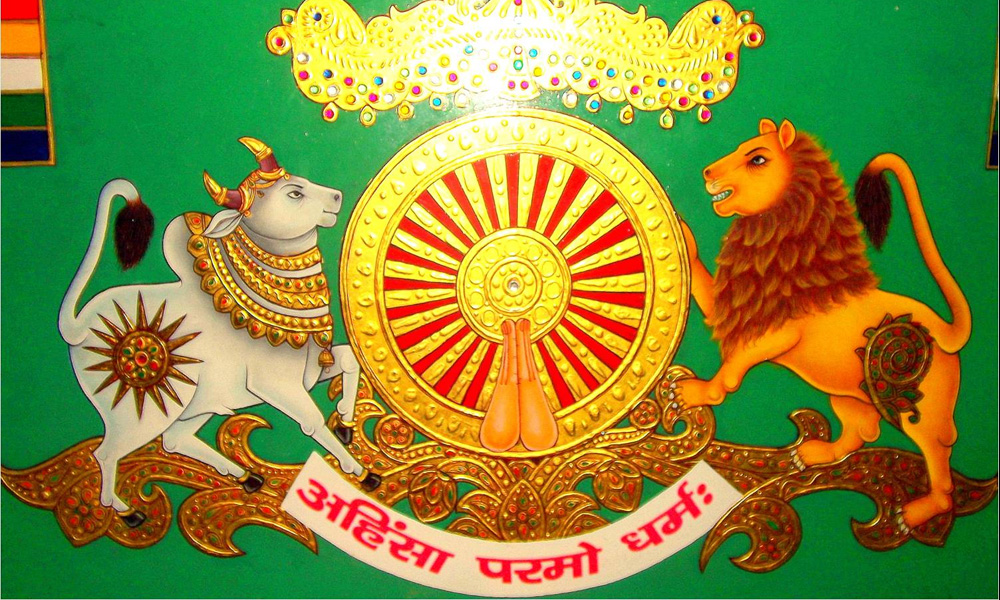
2. Truthfulness (Satya)
This aspect of Jainism is one of the most wrongly interpreted. We keep on telling the younger generations to speak truth as the fundamental aspect of Jainism. But, to speak truth is something we all learn in our moral class in grade 2 or 3! Lord Mahavira cannot list something of that grade as one of the 5 ‘Mahavrat’. There has to be something more to it. And so, at SRM we believe in this fundamental principle as to “choose right.” We have to discipline this human mind in such a way that whatever situation comes in life we must choose right action and right reaction. Thus, the fundamental principle of truthfulness states:
- To choose right, between right and wrong
- To choose eternal, between temporary and permanent
When one lives life through the learnings from Sadguru the essence of truthfulness starts pouring in the mind that enables the being to choose right and eternal in whatever stage of life they are.
3. Non-stealing (Achaurya)
The outcome of low intellect is the shallow interpretation of such powerfully intense words of enlightened beings. Achaurya Mahavrat is generally considered as not to steal others’ goods. But again, these are the ethical values that we learn at young ages. The enlightened stature of Lord Mahavira cannot deliver such a shallow message. There has to be something more to it.
The deepest message of enlightened masters can be decoded only when one’s consciousness is aligned to that state. Without that, we can only imagine some superficial meanings and can never understand the profound message behind these simple yet powerful words.
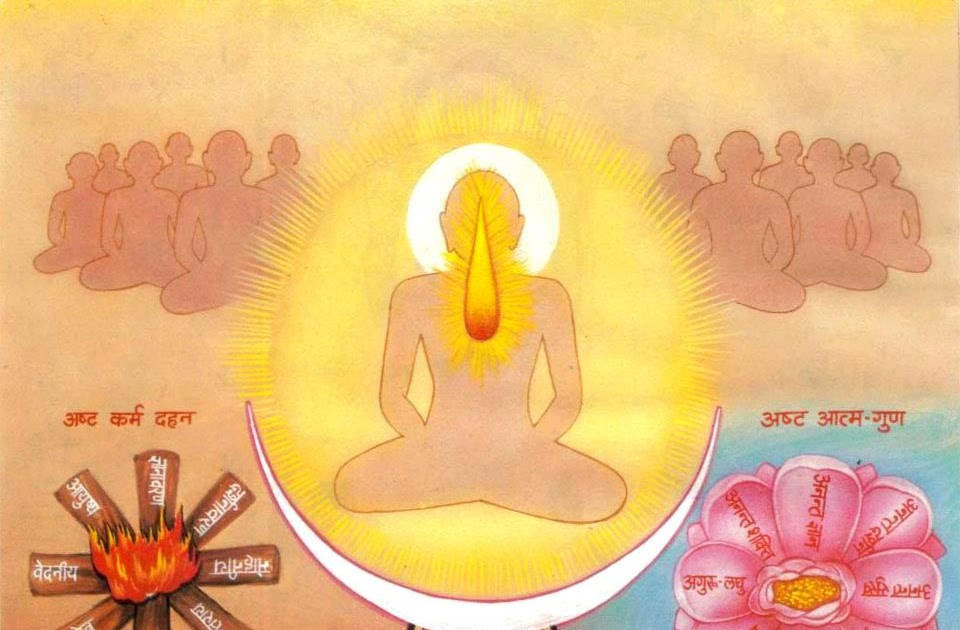
So, Achaurya literally means not to steal, consider or take away others’ things or possessions. But when it comes to deeper aspect, spiritually, it means not to consider body-mind-intellect as our own. Self is pure consciousness and body-mind-intellect are just the instruments of human life that enable us to know the True Self. For example, water in the pitcher — we know water can be contained in this pitcher but the pitcher is not water. Pitcher is here just to contain water, and it is the water that quenches the thirst and not the pitcher. Similarly, pure self is contained in body-mind-intellect but there not ‘Me’. In our state of ignorance we continuously claim body-mind-intellect as ‘Me’ and ‘mine’, i.e. the highest state of ‘Chaurya’ (stealing). Returning from such false notions and believing Self as only ‘Me’ and ‘Mine’, we abide to the fundamental principle of Achaurya.
4. Celibacy (Brahmacharya)
This is essentially the result of life lived with aforesaid 3 principles of non-violence, truthfulness and non-stealing. The actual word is ‘Brahma-charya’ which literally means to stay in Brahma (Soul). When a person chooses right over wrong and permanent Self over temporary body-mind-intellect then the result of this choice is simply returning to the Self (eternal consciousness). When we know that body-mind-intellect is not ‘Me’, then we naturally look towards what is ‘Me’? This primeval shift of consciousness towards Self is known as Brahmacharya.
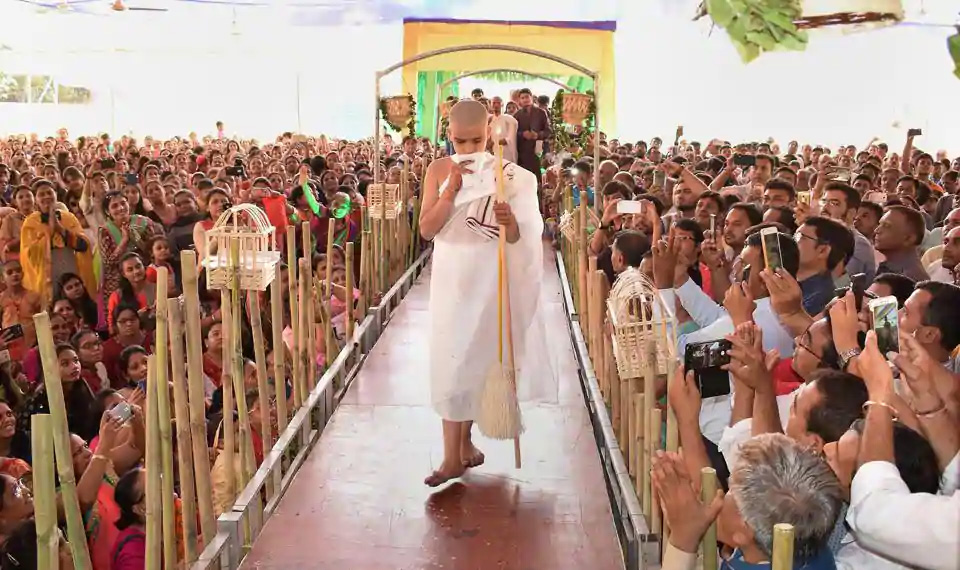
The result of withdrawing perception of body-mind-intellect as Self can be the state of celibacy. One can naturally abstain oneself from physical indulgence with other. The cravings of deriving pleasure from others’ touch-body-sense drops off easily when one experiences distress from their own body.
5. Non-Possessiveness (Aparigraha)
The one who awakes in Self and lives life with experiential knowledge of body-mind-intellect as not being his own lives the external life in the state of Aparigraha which is essentially the non-attachment to possessions. This non-attachment can be visibly felt to all levels of life and one is said to be living the path shown by Lord Mahavira. This non-possessiveness can be experienced as:
- Non-possessiveness of things — The more we know the eternal Self, lesser is the attachment towards the temporary things. So, with withdrawal and extension, availability and non-availability of things when one is not in the state of mental or physical agitation, it is called non-possessiveness of things.
- Non-possessiveness of people — On the stage of life, people come, play their role and go away. The one who knows the reality of this play of life goes beyond the drama and knows his True Self. A person living as ‘Jain’ is not obsessed by possession of people. They live happily in crowd or in seclusion, since their peace and happiness is no more derived from material world outside but from the eternal world of Soul within.
- Non-possessiveness of thoughts — People with this state of awareness (as explained above) are people of all-inclusive mindset. They do not possess insistence of their thoughts. They understand the aspect of relativity and respect everyone’s thought in relative realms. Nobody’s thought can be absolute because thoughts by nature cannot be absolute. The only absolute is True Self that is experienced beyond the state of thoughts.
In this way, the five fundamentals of Jainism is actually such a way of living that can be the cause of liberation through this human life. If one lives life in accord to these principles, they are taking the path of self-enquiry which finally leads to Self-Realisation.
Let us not devalue the words of great wisdom imparted by our enlightened Masters. Let us make them the way of life and experience the life, beyond body-mind-intellect, in the boundless existence of Pure Self.
Jainism
Jain community has survived test of the times
Published
5 years agoon
October 22, 2020By
Vedic Tribe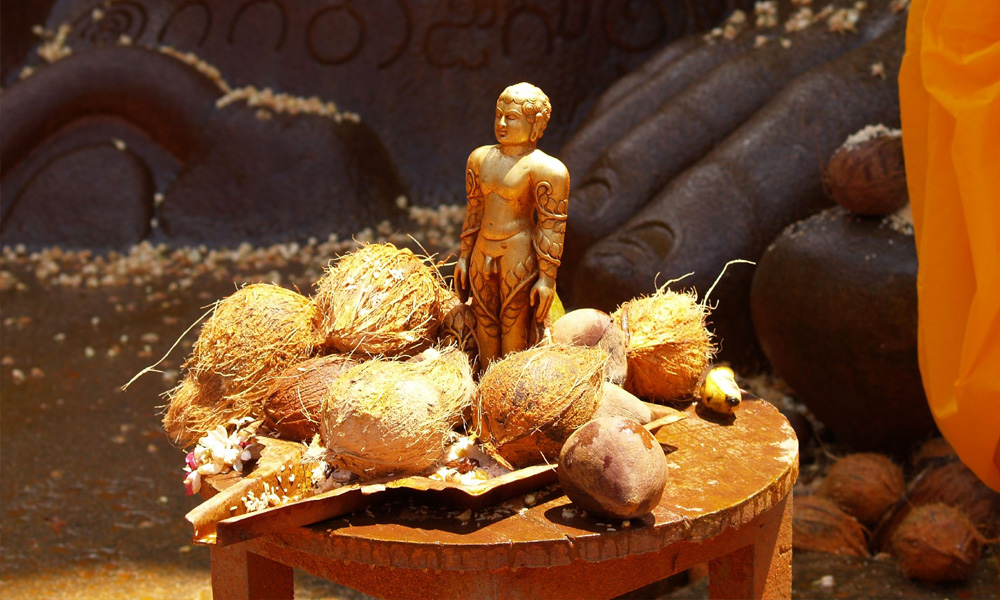
The community’s tenacity and survival can be attributed to its intra-community bonding and relative affluence as a result of engagement with trade and commerce as its primary occupation.
The Jain community of India was successful in sustaining their unique identity at a time when Buddhism — its contemporary religion — was in a state of decline to the point that it is considered virtually wiped out of India. The differing fates of the two non-vedic religions arouse curiosity in particular due to their many similarities as both Mahavira and Buddha, both kshatriyas from princely families turned saints who left the household in their prime, each founding a sangha consisting of both monastic and lay followers. Yet, an enigma stems from the decline and disappearance of Buddha’s religion in his native land, even as the Jain community survived in continuum, albeit without traveling outside India.
Although according to the 2011 census by religion, the number of Buddhists in India (0.84 crore) is in fact double the number of Jains (0.45 crore), most of them are a result of a revival of Buddhism in modern times such as the one embraced by a few Dalit communities and promulgated through the presence of a Tibetan diaspora in India.
The challenges faced by Buddhism and Jainism in the ancient period were quite similar. In spite of enjoying a period of ascendancy and royal favour for a few centuries, one of the greatest challenges to Buddhism and Jainism came from the resurgence of reformed Hinduism that began in the fourth and the fifth century AD.
According to Dr Padmanabh S Jaini, renowned scholar of Buddhism and Jainism at University of California Berkeley, the popularity of the various Hindu devotional cults and particularly of those associated with Rama and Krishna caused many defections from among the lay followers by suggesting that Rshabha, the first Tirthankara of Jains and Buddha had been incarnations of Vishnu. Jaini suggests that while the Buddhist monks were unprepared to respond to these grave development, the Jains “sought to outflank the bhakti movement by taking its main cult-figures as their own” by produced alternate versions of Ramayana and Mahabharata, in which Rama and Krishna were depicted as worldly Jaina heroes subject to laws of Jaina ethics. The ahimsa-practising Rama of Jaina Ramayana, for instance, does not kill Ravana (Lakshmana does it) and is reborn in heaven as a result.
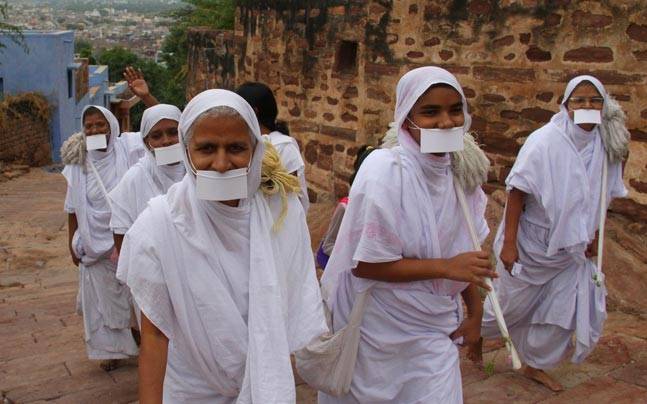
The Islamic invasion of the Indian subcontinent between twelfth and sixteenth century is generally recognised as era that dealt a setback to Indian religions, their worship places and idols. “Although a great number of Jaina temples in Gujarat and Rajasthan were converted into mosques in later centuries,” writes Jaini, adding, “the Jainas of those areas not only survived but were able to become important leaders in the economic life and government of the Muslim regimes”.
The Jain community of medieval India shared relatively harmonious bonds with Mughal ruling elite, via their spiritual leaders and affluent traders. Emperors like Akbar and Jahangir are known to have conferred royal favours and released farmans or imperial orders directing against slaughter of animals on certain stated days, such as the Jain festival of Paryushan, in places around Jain religious sites.
Dr Shalin Jain, Associate Professor of History at University of Delhi, attributes the community’s tenacity and survival to its cohesive organisation, intra-community bonding and relative affluence as a result of engagement with trade and commerce as its primary occupation.
Since Jains held that even unintentional activities generate karma, they sought to avoid not only those modes of livelihood that clearly and always cause harm to the living, but also any which might do so incidentally or occasionally. Almost from its inception, a number of common occupations including agriculture, animal transportation and animal by-product trades were thus deemed unsuitable for a practising Jain. “Eventually Jains came to largely eschew agriculture in all its forms and to specialise chiefly in trade and mercantile occupations, with the most favoured ones being jewellery-making and money-lending,” writes Dr Christopher Key Chapple, Professor of Indic theology at Loyola Marymount University. The community became very accomplished in these two fields and grew affluent, which historically helped its members stay influential and relevant in medieval India’s multi-cultural society.
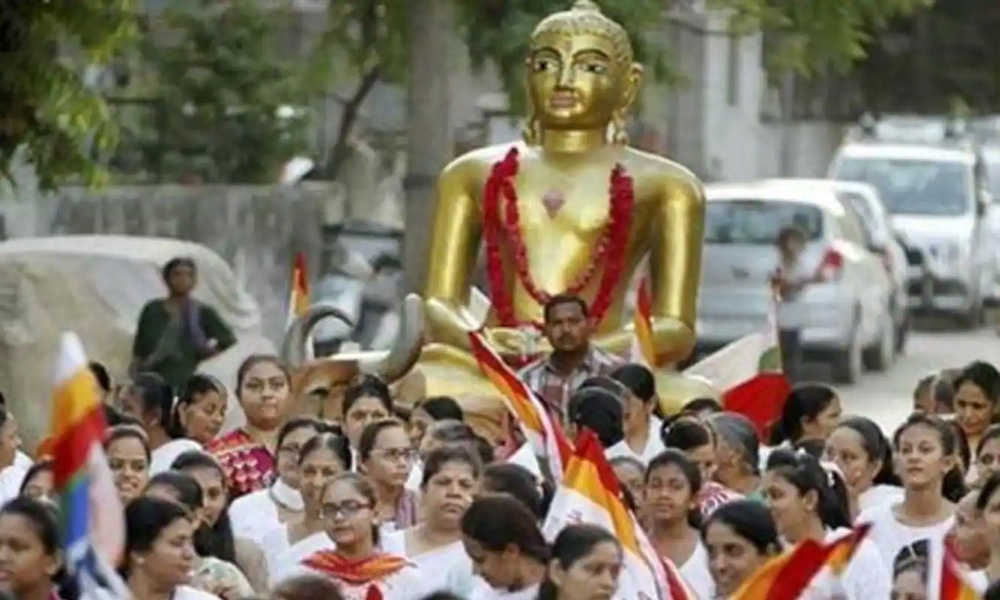
“If you look at the organisation of this community as envisaged in Jainism — the fourfold division of society known as the Chaturvidhasangha — a very deep, emotional bond exists between the community of Jain ascetics and the Jain laymen,” says Jain, “The ascetics completely depend on the lay people for food and shelter as they keep on traveling and have no permanent abode; the community in turn holds in deep respect the traditions of their monks and nuns. They invite and welcome them”. A similar bond between ascetics and lay followers of Buddhism did not exist.
Another strong pillar of Jain identity is its strong, unexceptionable emphasis on vegetarianism, which attributes it with a distinct identity. “In Jainism, both the ascetic and the householder subjectivity is weaved around the principle of ahimsa which is expressed formally through the prism of this dietary habit. This collective action of dietary habit leads to community formation,” says Jain, “Vegetarianism is there in Hinduism and Buddhism too, but there it is voluntary”.
Unlike these defining set of criteria that Jainism could rely on, Buddhism floundered due to a lack of such unifying criteria. While the Jains eventually produced some 50 manuals on conduct proper to a Jain lay person, Buddhists (as far as it is known) produced only one. The result of a weak Buddhist identity and a weak community connection among them.
Follow us on Facebook
Follow us on Twitter
Latest


Seven Vows and Steps (pheras) of Hindu Wedding explained
Views: 9,224 Indian marriages are well renowned around the world for all the rituals and events forming part of the...


Sari or Saree is symbol of Indian feminism and culture
Views: 7,441 One of the most sensual attires of a woman in India is undoubtedly the sari. It is a...


Atithi Devo Bhava meaning in Hinduism and India
Views: 7,211 Atithi Devo Bhava, an ancient line taken from the Hindu scriptures and was originally coined to depict a visiting person whose...


Sanskrit Is More Than Just A Method To Communicate
Views: 5,398 -By Ojaswita Krishnaa Chaturvedi anskrit is the language of ancient India, the earliest compilation of sound, syllables and...


Significance of Baisakhi / Vaisakhi
Views: 6,625 Baiskhi is also spelled ‘Vaisakhi’, and is a vibrant Festival considered to be an extremely important festival in...


Navaratri: The Nine Divine Nights of Maa Durga!
Views: 7,729 – Shri Gyan Rajhans Navratri or the nine holy days are auspicious days of the lunar calendar according...


History of Vastu Shastra
Views: 10,969 Vastu Shastra (or short just Vastu) is the Indian science of space and architecture and how we may...


Significance of Bilva Leaf – Why is it dear to Lord shiva?
Views: 10,582 – Arun Gopinath Hindus believe that the knowledge of medicinal plants is older than history itself, that it...


Concept of Time and Creation (‘Brahma Srishti’) in Padma Purana
Views: 10,861 Pulastya Maha Muni affirmed to Bhishma that Brahma was Narayana Himself and that in reality he was Eternal....


Karma Yoga – Yog Through Selfless Actions
Views: 9,735 Karma Yoga is Meditation in Action: “Karma” means action and “yoga” means loving unity of our mind with...


